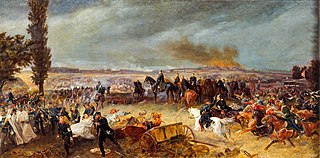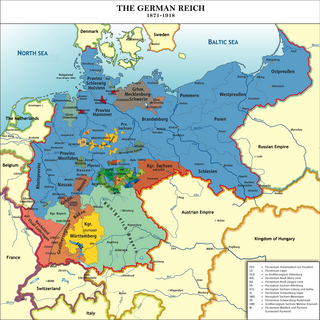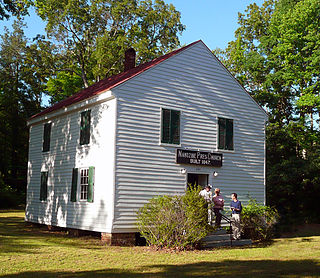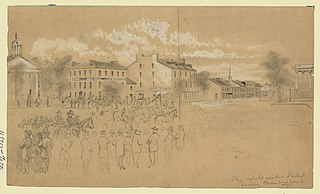Related Research Articles

The Franco-Prussian War or Franco-German War, often referred to in France as the War of 1870, was a conflict between the Second French Empire and the North German Confederation led by the Kingdom of Prussia. Lasting from 19 July 1870 to 28 January 1871, the conflict was caused primarily by France's determination to restore its dominant position in continental Europe, which it had lost following Prussia's crushing victory over Austria in 1866. According to some historians, Prussian chancellor Otto von Bismarck deliberately provoked the French into declaring war on Prussia in order to draw four independent southern German states—Baden, Württemberg, Bavaria and Hesse-Darmstadt—to join the North German Confederation; other historians contend that Bismarck exploited the circumstances as they unfolded. None, however, dispute that Bismarck likely recognized the potential for new German alliances, given the situation as a whole.

The Austro-Prussian War, Seven Weeks' War, German Civil War, Brothers War or Fraternal War, known in Germany as Deutscher Krieg, Deutscher Bruderkrieg and by a variety of other names, was fought in 1866 between the Austrian Empire and the Kingdom of Prussia, with each also being aided by various allies within the German Confederation. Prussia had also allied with the Kingdom of Italy, linking this conflict to the Third Independence War of Italian unification. The Austro-Prussian War was part of the wider rivalry between Austria and Prussia, and resulted in Prussian dominance over the German states.

The Battle of Königgrätz was the decisive battle of the Austro-Prussian War in which the Kingdom of Prussia defeated the Austrian Empire. It took place on 3 July 1866, near the Bohemian towns of Königgrätz, and Sadowa.

The Pour le Mérite is an order of merit established in 1740 by King Frederick II of Prussia. The Pour le Mérite was awarded as both a military and civil honour and ranked, along with the Order of the Black Eagle, the Order of the Red Eagle and the House Order of Hohenzollern, among the highest orders of merit in the Kingdom of Prussia. After 1871, when the various German kingdoms, grand duchies, duchies, principalities and Hanseatic city states had come together under Prussian leadership to form the federally structured German Empire, the Prussian honours gradually assumed, at least in public perception, the status of honours of Imperial Germany, even though many honours of the various German states continued to be awarded.

The Battle of Sedan was fought during the Franco-Prussian War from 1 to 2 September 1870. Resulting in the capture of Emperor Napoleon III and over a hundred thousand troops, it effectively decided the war in favour of Prussia and its allies, though fighting continued under a new French government.

The German General Staff, originally the Prussian General Staff and officially Great General Staff, was a full-time body at the head of the Prussian Army and later, the German Army, responsible for the continuous study of all aspects of war, and for drawing up and reviewing plans for mobilization or campaign. It existed unofficially from 1806, and was formally established by law in 1814, the first general staff in existence. It was distinguished by the formal selection of its officers by intelligence and proven merit rather than patronage or wealth, and by the exhaustive and rigorously structured training which its staff officers undertook. Its rise and development gave the German armed forces a decisive strategic advantage over their adversaries for nearly a century and a half.

Helmuth Karl Bernhard Graf von Moltke was a Prussian field marshal. The chief of staff of the Prussian Army for thirty years, he is regarded as the creator of a new, more modern method of directing armies in the field. He commanded troops in Europe and the Middle East, commanding during the Second Schleswig War, Austro-Prussian War and the Franco-Prussian War. He is described as embodying "Prussian military organization and tactical genius." He was fascinated with railways and pioneered their military usage. He is often referred to as Moltke the Elder to distinguish him from his nephew Helmuth von Moltke the Younger, who commanded the German Army at the outbreak of World War I.

Prince Friedrich Karl Nikolaus of Prussia was the son of Prince Charles of Prussia (1801–1883) and his wife, Princess Marie of Saxe-Weimar-Eisenach (1808–1877). Prince Friedrich Karl was a grandson of King Frederick William III of Prussia and a nephew of Frederick William IV and William I.

The Battle of Gravelotte on 18 August 1870 was the largest battle of the Franco-Prussian War. Named after Gravelotte, a village in Lorraine, it was fought about 6 miles (9.7 km) west of Metz, where on the previous day, having intercepted the French army's retreat to the west at the Battle of Mars-La-Tour, the Prussians were now closing in to complete the destruction of the French forces.

The unification of Germany into the German Empire, a Prussian-dominated nation state with federal features, officially occurred on 18 January 1871 at the Palace of Versailles in France. Princes of most of the German states gathered there to proclaim King Wilhelm I of Prussia as German Emperor during the Franco-Prussian War.

The northern Virginia campaign, also known as the second Bull Run campaign or second Manassas campaign, was a series of battles fought in Virginia during August and September 1862 in the Eastern Theater of the American Civil War. Confederate General Robert E. Lee followed up his successes of the Seven Days Battles in the Peninsula campaign by moving north toward Washington, D.C., and defeating Maj. Gen. John Pope and his Army of Virginia.

The Battle of Spicheren, also known as the Battle of Forbach, was a battle during the Franco-Prussian War. The German victory compelled the French to withdraw to the defenses of Metz. The Battle of Spicheren, on 6 August, was the second of three critical French defeats. Moltke had originally planned to keep Bazaine's army on the Saar river until he could attack it with the 2nd Army in front and the 1st Army on its left flank, while the 3rd Army closed towards the rear. The aging General von Steinmetz made an overzealous, unplanned move, leading the 1st Army south from his position on the Moselle. He moved straight toward the town of Spicheren, cutting off Prince Frederick Charles from his forward cavalry units in the process.

The Battle of Namozine Church, Virginia, was an engagement between Union Army and Confederate States Army forces that occurred on April 3, 1865, during the Appomattox Campaign of the American Civil War. The battle was the first engagement between units of General Robert E. Lee's Confederate Army of Northern Virginia after that army's evacuation of Petersburg and Richmond, Virginia, on April 2, 1865, and units of the Union Army under the immediate command of Maj. Gen. Philip Sheridan, who was still acting independently as commander of the Army of the Shenandoah, and under the overall direction of Union General-in-Chief Lt. Gen. Ulysses S. Grant. The forces immediately engaged in the battle were brigades of the cavalry division of Union Brig. Gen. and Brevet Maj. Gen. George Armstrong Custer, especially the brigade of Colonel and Brevet Brig. Gen. William Wells, and the Confederate rear guard cavalry brigades of Brig. Gen. William P. Roberts and Brig. Gen. Rufus Barringer and later in the engagement, Confederate infantry from the division of Maj. Gen. Bushrod Johnson.

The Royal Prussian Army served as the army of the Kingdom of Prussia. It became vital to the development of Brandenburg-Prussia as a European power.

The Cavalry Corps of the Army of Northern Virginia was an organized unit of cavalry in the Confederate Army during the American Civil War. Starting out as a brigade in late 1861, becoming a division in 1862 and finally a Corps in 1863; it served in the Eastern Theater until the ANV's surrender in April 1865.

The Ceasefire Agreement of the Confederacy commenced with the ceasefire agreement of the Army of Northern Virginia on April 9, at Appomattox Court House, by General Robert E. Lee and concluded with the ceasefire agreement of the Shenandoah on November 6, 1865, bringing the hostilities of the American Civil War to a close.
Captain Justus Scheibert (1831–1903) was a Prussian army officer, sent by Prussia to America to observe the American Civil War in order to learn the lessons to be learned and return to Prussia to teach these lessons to the Prussian troops. His writings became a source of Prussian, and later German, military strategy through five subsequent wars.

The Raid on Chambersburg, often identified as J.E.B. Stuart's Chambersburg Raid, was a Confederate States Army cavalry raid into Maryland and Pennsylvania on October 10–12, 1862 during the American Civil War. It became known as Stuart's "second ride around McClellan" because it duplicated Stuart's reconnaissance ride completely around the Union Army of the Potomac under Major General George B. McClellan during the ill-fated Peninsula Campaign.

The Battle of Artenay' also known as the Battle of Arthenay, is a battle in the Franco-Prussian War, was held on October 10, 1870, in Artenay a small town located on the road from Orléans to Paris, France which was about 10 miles north of the city of Orléans. In this fierce battle, with superior strength compared to the opponent, The I Corps of the Kingdom of Bavaria, under the command of Lieutenant General Ludwig von der Tann-Rathsamhausen, in collaboration with the 22nd Division of the XI Corps of the Kingdom of Prussia and the two cavalry divisions of the Prussian army attacked and penetrated the defense system of the army of the Loire of the young French Republic, under the control of general Joseph Edouard de la Motterouge, causing heavy losses for the French military of which many people were taken prisoner. The winning conditions Artenay were favorable enough for Von der Tann to stike Orléans, while the forces of France knocked back on Orléans forest in an agitated state. Despite this, Nièvre's Garde Mobiles and the Pontifical Legion in the French army were noted for their strong resistance, while a monk in Prussian Cavalry under the command of Prince Albrecht demonstrated his prowess in the battle at Artenay.
The Battle of Ladon and Mézières was a battle fought at Ladon and Mézières-en-Gâtinais between the French Army of the Loire led by Louis d'Aurelle de Paladines and Imperial German Army led by Prince Friedrich Karl of Prussia on November 17, 1870. During the battle the Prussians forced the French forces to retreat into the Bellegarde woods. Although the French army was quickly defeated in this battle, it showed the Prussians the substantial size of the French XX corps. the engagement showed the Germans that substantial forces of the French XX Corps were present on the battlefield. The defeat caused great damage to French morale. On November 17 the French attacked the Prussians again at the Battle of Beaune-la-Rolande, but they were defeated again.
References
- Cartmell, Donald (2001). The Civil War book of lists. Career Press. ISBN 1-56414-504-2 . Retrieved 25 April 2009.
- Glatthaar, Joseph (2001). The American Civil War: the war in the West, 1863-1865. Osprey Publishing. ISBN 1-84176-242-3.
- Heidler, David (2002). Encyclopedia Of The American Civil War. W. W. Norton & Company. ISBN 0-393-04758-X.
- Mackey, Robert (2005). The Uncivil War: Irregular Warfare in the Upper South, 1861-1865. University of Oklahoma Press. ISBN 0-8061-3736-3.
- O'Brien, Cormac (2007). Secret Lives of the Civil War: What Your Teachers Never Told You about the War Between the States. Quirk Books. ISBN 1-59474-138-7.
- Robins, Edward (1905). William T. Sherman. George W. Jacobs & Co. ISBN 1-56414-504-2 . Retrieved 11 July 2013.
- Scheibert, Justus (2001). Frederic Trautmann (ed.). A Prussian observes the American Civil War: the military studies of Justus Scheibert . University of Missouri Press. ISBN 0-8262-1348-0.